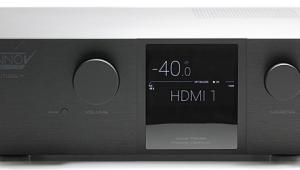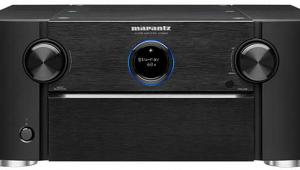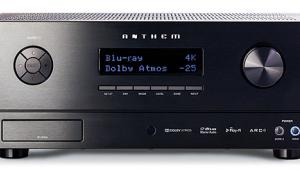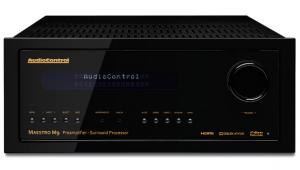Nice review David. Did you get a chance to compare the excellent dacs of the Oppo 95 with the dacs of the Outlaw when listening to 2channel music? Great job and thanks again.
Outlaw Model 975 Surround Processor

Remember the days when being the middleman of a business transaction reaped all kinds of rewards? Times have certainly changed in this regard with the invention of the Internet. The traditional distribution channels for electronics have been reshaped, and businesses that can't adapt—Circuit City, The Good Guys, and many specialty A/V retailers—are either extinct or on the express train to bankruptcy court. I'm talking about you, Best Buy.
How consumers buy electronics has evolved to where Amazon.com is king of the world, but there are some companies out there that are adapting in a different way. Outlaw Audio is a great example of this. It designs and manufactures its own brand of audio/video components and sells them directly to the consumer through its own Website. This eliminates the extra markup needed to support a brick-and-mortar retail store and in turn potentially gives consumers more performance for their buck.
Some years ago at a trade show, a group of audio/video product designers, engineers, and marketers who had been around the consumer electronics industry for decades got together for the first time and formed Outlaw. Since its inception, the company has offered some of the best values in the A/V business with preamp/processors, AVRs, and multichannel amplifiers, and it’s hung its hat on delivering first-class customer service.
It's been a number of years since Outlaw has released a new pre/pro, but with the launch of the Model 975, it’s back with a vengeance. While most manufacturers are adding more bells and whistles to their pre/pros, Outlaw has gone in the other direction. You won't find any network connectivity, room correction software, balanced inputs/outputs, or multizone capability on the Model 975, but that's OK—you can't have it all for $549. What you get is a simple-to-use surround processor tailor-made for the A/V enthusiast who has always wanted to venture into the world of separates for the promised benefit of better sound quality, but has found the price of entry too steep.
Not So Plain Jane
When the Model 975 arrived at my home, I was shocked by how light the shipping box was—about 10 pounds. When I opened it, I thought I was sent a Blu-ray player by mistake. To say this pre/pro is dainty would be an understatement. At just under 3 inches tall, the processor has a smaller footprint than my Oppo BDP-95—but don't let its size deceive you.
The aluminum front panel has a simple yet functional design. The power button is located on the left-hand side of the unit along with a headphone jack. In the center of the front panel is a text-based LCD display, and on the right is the volume knob along with five control buttons (Tuner, Tune Mode, Input, Surr Mode, and Mute). The rear of the Model 975 is highlighted by four HDMI 1.4 inputs (with 3D support) and one HDMI output. Additionally, there are two each of component, S-video, and composite video inputs along with one output of each. Audio connections include five sets of analog inputs, two optical digital, and two coaxial inputs, with one set of analog outputs for connection to an analog recording device. Rounding things out is a 12v trigger port, AM and FM antenna terminals, and an RS-232 port for update and service needs only—it’s not intended for communication with a control system.
 Inside the box is a proprietary video processing solution that allows for passthrough of the native signal, or for each input to be independently scaled to up to 1080p—so you can have the signal from your set-top box scaled and leave the 1080p/24 output from your Blu-ray player untouched. The video processor also includes some basic video adjustments (Brightness, Contrast, Hue, Saturation, and Aspect Ratio) that are global for any input that's being processed in the unit, but these adjustments are better left untouched and handled by your display.
Inside the box is a proprietary video processing solution that allows for passthrough of the native signal, or for each input to be independently scaled to up to 1080p—so you can have the signal from your set-top box scaled and leave the 1080p/24 output from your Blu-ray player untouched. The video processor also includes some basic video adjustments (Brightness, Contrast, Hue, Saturation, and Aspect Ratio) that are global for any input that's being processed in the unit, but these adjustments are better left untouched and handled by your display.
The Model 975 utilizes 192-kilohertz/24-bit DACs for all channels with a 32-bit CS- 497024 Crystal processor. This processor has its own room correction algorithm on board, but Outlaw decided not to implement it since it didn't meet the company’s high standards for audio performance. The pre/pro can decode and play back all the latest high-resolution audio codecs such as DTS-HD Master Audio and Dolby TrueHD, as well as the legacy codecs from each company. What you won't find in the Model 975 are a bunch of hokey and rarely used DSP modes such as Stadium, Club, etc. Instead, the unit offers All Channel Stereo, various Pro Logic II modes including Pro Logic IIx for traditional 7.1 setups with two back surround speakers and Pro Logic IIz if you want to add two additional height speakers to the front of the room.
User Interface
Without an auto setup or room calibration program, setting up the Model 975 for the first time is a manual affair that's made even easier due to the extremely well-written manual. I connected the pre/pro to my Anthem PVA 7 amp via BetterCables analog interconnects and hooked up my source components including a TiVo Series 3 DVR, an Oppo BDP-95 Blu-ray player, and a Squeezebox Touch connected to a Windows Home Server.
The Model 975's setup menu is easy to navigate, although its layout and rudimentary design with text-based display makes it look dated. In there you'll find setup options that include Speaker, Input, Video, Audio, Video Output, and Advanced Dolby/DTS.
The Speaker Setup menu includes options for up to a 7.1 system. This is where you set your speakers to Small or Large, set the crossover setting (from 40 hertz up to 200 Hz), and identify whether you're using front height, single surround back, or dual-surround back speakers. Next, you have to manually enter your speaker distances (in feet or meters) and calibrate the speaker levels using an SPL (sound pressure level) meter to set the individual volume level for each speaker. One small glitch: unlike most pre/pros and AVRs, the volume level for the test tone is set at the last volume you were listening to before entering the setup and can't be adjusted once you’re inside the menu system. So to ensure that you have at least a 75-decibel output from the test tone, you must venture in and out of the Setup menu to reach the right volume level. Another option is to use the display on the front of the unit instead of the onscreen menu to set the speaker levels with the remote—this was the method I ended up using.
- Log in or register to post comments


I will like to purchase this system, how I can hook up thouse babys to get the best results, I want lossless audio output and the best hd picture, how can set up the 975 to interact with the rest, the amp 7075 and the Sony BDP-S790

I'd like to hear some feedback from people that bought this unit after reading this review and see if they had the same experience as the reviewer.






























































